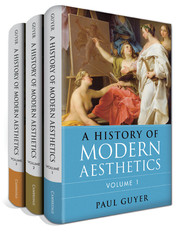Book contents
- Volume 1 The Eighteenth Century
- Volume 2 The Nineteenth Century
- Volume 3 The Twentieth Century
- Frontmatter
- Contents
- Acknowledgments
- Introduction
- Part One German Aesthetics in the Twentieth Century
- Part Two Aesthetics in Britain until World War II
- 3 Bloomsbury, Croce, and Bullough
- 4 First Responses to Croce
- 5 Collingwood
- Part Three American Aesthetics in the First Half of the Twentieth Century
- Part Four Wittgenstein and After
- Bibliography
- References
3 - Bloomsbury, Croce, and Bullough
from Part Two - Aesthetics in Britain until World War II
Published online by Cambridge University Press: 05 June 2015
- Volume 1 The Eighteenth Century
- Volume 2 The Nineteenth Century
- Volume 3 The Twentieth Century
- Frontmatter
- Contents
- Acknowledgments
- Introduction
- Part One German Aesthetics in the Twentieth Century
- Part Two Aesthetics in Britain until World War II
- 3 Bloomsbury, Croce, and Bullough
- 4 First Responses to Croce
- 5 Collingwood
- Part Three American Aesthetics in the First Half of the Twentieth Century
- Part Four Wittgenstein and After
- Bibliography
- References
Summary
In this chapter, we will consider the foremost contributors to aesthetics in Britain between the turn of the twentieth century and the outbreak of World War I. These are the art theorists Clive Bell and Roger Fry, the Italian philosopher Benedetto Croce, and the Cambridge professor of German and Italian literature Edward Bullough. The Italian Croce is included in this chapter because of his enormous influence on British aesthetics, ultimately greater than that of any of the others mentioned, and indeed his chief book on aesthetics, published in Italian in 1902 and translated into English in 1909, precedes the works of the others named. For that reason, it might seem natural to begin the chapter with Croce. But since the aesthetic theory of Clive Bell, although not published until 1914, can be seen as a philosophical version of the aestheticism of the previous century, we will begin with him in order to pick up the thread from our previous discussion of British aesthetics in Volume 2. And since it was Croce rather than Bell who had the greatest impact on British aesthetics in the decades after the First World War, it will create more continuity with what follows if we discuss him after Bell rather than before.
Bell’s thought about aesthetics developed within the intellectual atmosphere created by the Cambridge philosopher G.E. Moore, especially by his Principia Ethica of 1903. So this chapter will begin with a brief discussion of Moore. Bell’s name is also typically associated with that of his fellow art critic Roger Fry, so we will discuss him after our treatment of Bell, arguing that their views should not be so closely identified as is often done. After our discussion of Croce, the chapter will then conclude with an examination of the work of Bullough.
- Type
- Chapter
- Information
- A History of Modern Aesthetics , pp. 108 - 157Publisher: Cambridge University PressPrint publication year: 2014



